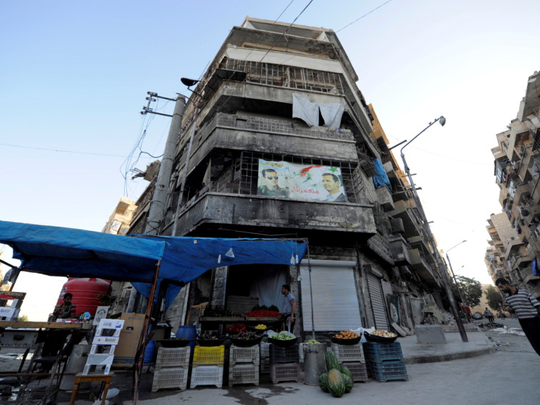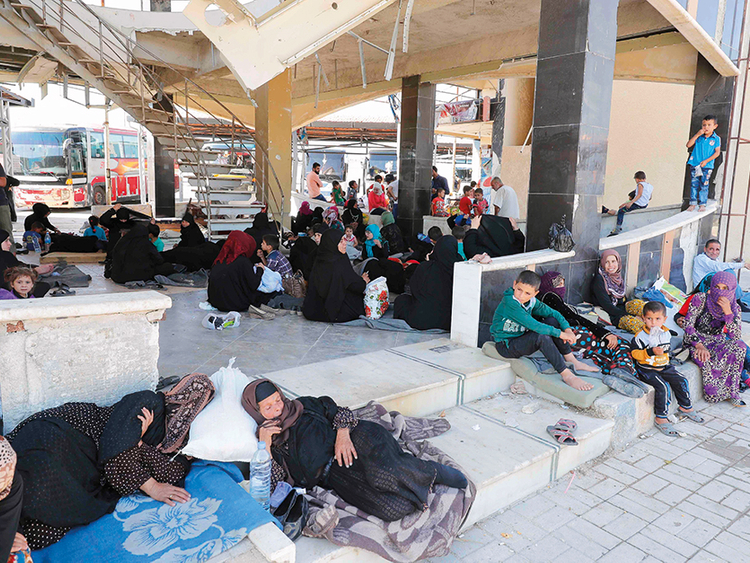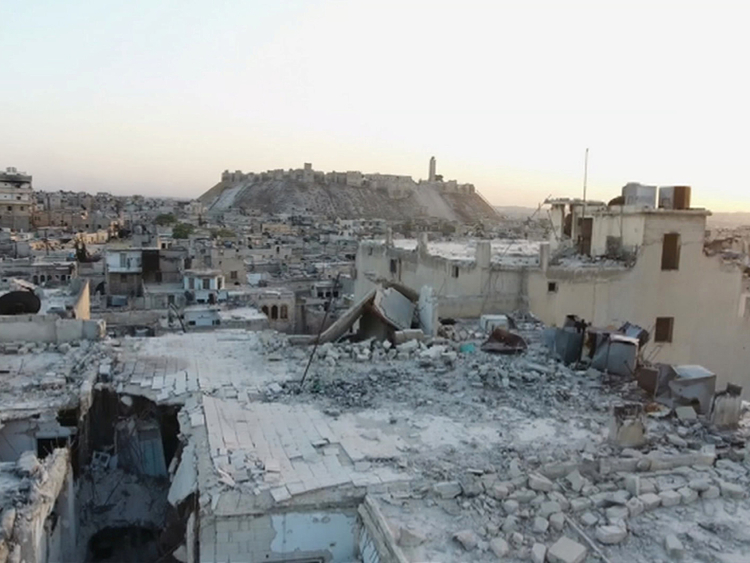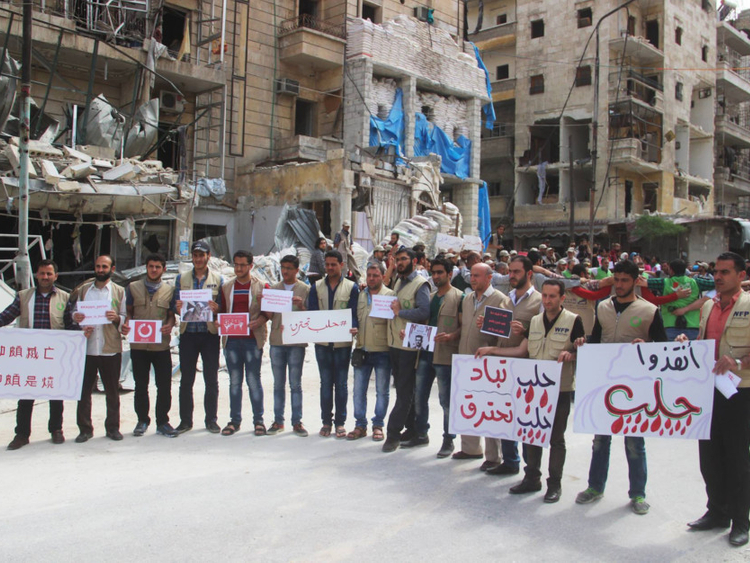
A plane goes by, minutes pass. I am sipping tea at my cousin’s home in western Aleppo.
A few miles away, something explodes. I jump.
“Relax, that’s nothing.” My cousin doesn’t flinch. “You should have heard when it was the building next door.”
The Syrian regime and its allies were trying to push back the western front outside Aleppo, my home town, in April.
The city had been the centre of the Syrian war for almost five years; the regime had recaptured the eastern side just four months earlier.
Key highways and areas outside the city, however, were still being fought over.
Rebels were retrenching on the western city limits, in the direction of the explosion, and Daesh lurked an hour’s drive east.
This was the first time I’d been able to come home since my parents and I left in 2011; for almost six years, I had watched my city fall apart from afar.
Security had improved since the government retook the east, and a few like me, who’d fled the fighting, were chancing a trip back.
I returned to Aleppo knowing that it wouldn’t be the same place I’d left. But none of my caution could prepare me for what had unfolded — or the things people had done to survive.
$360 taxi ride
I had arrived the day before from Beirut, with one of the many drivers who make a living ferrying passengers across the border and back, charging about $360 (Dh1,322) per car for the 800-kilometre round trip.
I wanted to find cherished things I’d left behind — diaries, photo albums, my birth certificate — and to see what had happened to people I cared about.
Mohammad (not his real name) picked me up in Beirut at 2.30am.
He ripped the airline tags off my luggage and introduced me to the other passengers sharing the ride: two well-heeled women returning from France and Saudi Arabia, where they had been living for several years, to visit the homes they had left behind.
He told us we would arrive sometime between 9am and noon, depending on unpredictable border guards and the particularly dangerous Khanaser road, which led to our city.
Mohammad had a lead foot and a golden tongue that could get him out of any trouble.
We breezed through the border crossings by saying as little as possible.
Checkpoints
Once in Syria, he greeted many of the soldiers stationed at the 20-plus checkpoints by name, and he knew which checkpoints to speed through without stopping.
“These guys aren’t the army,” he said after racing by two men dressed in camouflage who had set up two tyres along the road. “They just want money.”
They could pick up about 40 cents from each car that passed, Mohammad told us, enough to buy a stack of bread or a large water bottle.
“Where are you headed?” asked every soldier who stopped us.
Mohammad had a military ID — he didn’t say how — and after he handed it over for inspection, he would announce our destination.
Our endpoint and our origin changed during the trip to the nearest cities, because everyone knew that if you were travelling far, you would have cash in your pockets.
The first five hours of the trip were quiet, much like a road trip through the American Midwest (except for the squat toilets at rest stops).
Mohammad bought us coffee and told us about his asylum interviews in Anglophone embassies.
He was hoping to give his family a better life in the West, but he worried that if his interviewers found out what he did for a living, they would reject him.
The singer Fairuz played on the radio as the sun came up.
Khanaser Route
At 7am, Mohammad parked behind a line of trucks carrying cargo hidden by nylon covers checkered with faded United Nations logos.
“Now we wait for them to open the Khanaser route. It usually happens around 8am.”
The infamous Khanaser route is a narrow, 50-kilometre strip of road controlled by the Syrian regime.
At the time, Daesh hid in the hills a few miles to the east. A few miles to the west was the Al Qaida-affiliated Jabhat Fatah Al Sham.
Every day, the regime soldiers who secured the road allowed cargo trucks and civilian vehicles to pass for a few hours before the fighting resumed at night — a sort of unspoken truce, it seemed, though I could not confirm it.
The route is Aleppo’s lifeline to the rest of the country and thus very valuable to those who control it.
About 8am, the men chatting near their vehicles walked back and started their engines. Within seconds, our car was speeding past the trucks at 150km/h.
“I know you love your speed, but is this really necessary?” I asked. I clutched the door and sank into my seat.
“Listen,” Mohammad began, “this is an open and exposed road. There’s the Russian tank Daesh blew up a few months ago.”
We zoomed by the machine’s ashy carcass on the side of the road, along with a few tall mounds of dirt and three truck skeletons. If no one had moved these, I thought, it was probably because it was too dangerous to try.
Remnants of destroyed city
A little more than an hour after crossing through Khanaser, we approached the remnants of a destroyed city. Shepherds guided their sheep alongside the road, near roofs that looked like they’d been pressed down until one corner touched the ground.
These sunken-cake buildings grew in number, and after we crossed the final checkpoint at the eastern city limit of Aleppo, they dominated the landscape.
Eastern Aleppo, the larger of the city’s two sides, had borne the brunt of the fight and had often been shelled.
Now it resembled a ghost town, with occasional signs of life. The man walking down the street, the clotheslines on balconies of the few buildings that still stood, the storefront with the rolled-up metal shutter.
“Stop taking pictures!” Mohammad said to me several times.
We hugged the outer ring road, travelling around the northern part of Aleppo, and eventually we reached the western side.
The west, which had been controlled by the regime throughout the conflict, had seen significantly less damage. It was exactly as I remembered it.
The buildings were almost all intact, and the streets had potholes but were brimming with traffic.
Stalls were set up along almost every road: food, cellphone cases, bread, lamps.
People were everywhere, children mostly, crossing the streets at every angle and every pace.
“You should have been here a few months ago,” almost everyone I saw over the next few days told me. “It was completely different.”
One hotel remains
I caught up with cousins, family friends, parents of friends who had moved abroad, and friends who remained. I joined my parents, who had arrived a few days earlier and were staying at the only remaining hotel in the city, the Cham Palace.
They all told me their stories.
One friend, whose husband worked as a trauma surgeon at the University Hospital in western Aleppo, showed me a handful of odd objects he extracted from patients and clandestinely kept as a reminder.
“He pulled a mortar shell propeller out of a patient’s body,” she said. “I have some sentimental attachment to this bullet, because it flew by my foot.”
Before December 2016, residents of western Aleppo mainly feared three types of falling objects: short-range propelled mortar shells, rocket-propelled grenades and bullets, mostly being hurled from the east.
Any of them could kill a person out in the open, in a car or in their home. But the west doesn’t have sunken cakes.
My cousin could not believe I had actually returned.
She had earned her degree in biotechnology from the University of Aleppo but was having trouble finding a job in her field.
Inflation
Most people were having trouble finding any job. And those who did were paid prewar salaries, even though inflation had risen tenfold.
Even if it has fared better than the eastern side, western Aleppo still lacks basic services. Running water comes and goes throughout the day now, but before December it could come once a week for an hour.
My best friend’s mum would fill a container and use it all week: cleaning, showering, cooking. In the freezing winter, when heating gas was close to nonexistent, bathing was optional.
“I would dread taking a shower in the winter because the bathroom was too cold,” my cousin said.
Electricity was also sporadic when the city was divided, but today its availability has created a luxury market of its own. What used to be an organised grid is now a tangle of wires suspended between buildings and street posts, providing those who pay with “ampere,” or amps.
One amp powers a fridge and a lightbulb and costs roughly $3 per week, paid to the city.
Everywhere, unfinished buildings are boarded up and used as shelters. So are old schools, mosque halls, abandoned homes, empty offices.
Displaced people from destroyed parts of the city or nearby towns live, officially or unofficially, in every possible space the city has to offer.
“People broke into my dad’s office downtown and started living there, so he had to force them out,” my friend told me, referring to an unused office.
On my third day in Aleppo, my father and I returned to the Old City, the historic quarter he had dedicated most of his career as an architect to preserving.
The neighbourhood, nestled between the eastern and western sides of town, is roughly the size of Central Park.
It’s one of the oldest continuously inhabited urban areas in the world, but Unesco now estimates that 60 per cent has been “severely damaged” by fighting.
We were searching for the old courtyard house turned office where my father had worked for decades.
At first we attempted to follow a familiar route from a relatively intact neighbourhood just west of the Old City.
But every time we set off into the maze, we found dead ends: a few metal barrels over a mound of dirt blocking the four-foot-wide street.
“Don’t! There may be mines,” a friend who’d driven us into the Old City said when I tried to climb over.
The roads here were too narrow for a tank or a large army to move through quickly.
The streets were lined with adjoining two-storey houses, so soldiers had blown holes in the walls between them to move across the district undetected.
By climbing through these holes, we finally found the office, which had survived, even though everything across the street from it hadn’t.
–Washington Post
Jwanah Qudsi, who grew up in Aleppo, works for the United Nations in New York.
















